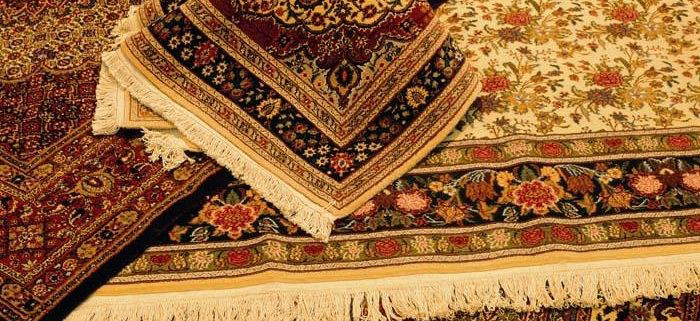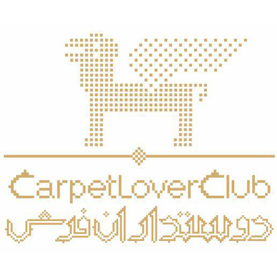what is the stages of persian handmade carpet weaving?
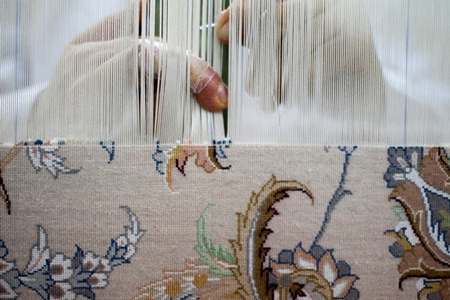
First, an artist creates the rug’s design. Next, wool is dyed in the colors needed. The loom that the piece will be woven on resembles a harp, except that it is rectangular rather than v-shaped and has many more “strings” (called warps). The weaver knots a colored tuft of wool to the base of each of the “strings”. The colored tufts of wool emerging from these knots will form the rug’s soft surface and design. After a tuft has been knotted to each “string” along the bottom of the “harp”, the weaver threads a strand of wool or cotton (called the weft) in and out of each of these “strings,” directly above the tufts. Then, she uses a heavy “comb” to beat the weft strand down atop the tufts. A new set of tufts is then knotted to the “strings” above this, and the process is repeated over and over until the rug is complete. A persian rug contains thousands of knots and usually requires months to complete!
how much time required to weave a Persian rug?
The length of time required to weave a Persian rug depends upon its size, the number of weavers working on it, the density of its knots, and the complexity of its design. The amount of craftsmanship and time required to create a rug is staggering. 8′x10′ rugs typically require 3 weavers working six to eight months to produce. The loom time of the finest of rugs is exponentially longer.
how much durable is handmade carpet?

This depends upon the quality of the rug itself. It’s not at all unusual for quality hand-knotted rugs to last generations. And, this is with the punishment doled out by several generations of a family. Fine rugs are not fragile, they are tough as nails. What makes them so durable? A quality hand-knotted rug is composed of an excellent wool. What’s the importance of this? Cheap wool is like the dried ends of hair. It’s brittle and sheds incessantly. It is not springy and mats down quickly, making a rug look quite “used”. It lacks lanolin (wool’s natural stain repellant) and welcomes stains. Good wool is springy and resilient and repels stains. Wouldn’t most rugs be made with a good wool? No. An excellent wool is expensive and quite a bit of it is needed to produce a rug. Even many hand-knotted products “cut corners” and use inferior wool. Besides wool quality, a rug’s construction (how it’s made) affects its durability. In the case of hand-knotted rugs, every tuft of wool is knotted in place. Conversely, so called “hand-tufted” and “hand-hooked” rugs use latex rubber to hold their wool in place. Within a short period of time latex breaks down and turns into a powder. This creates quite a mess. Moreover, the wool begins coming out of the rug. In short, if you want a gorgeous rug that wears like iron, purchase a hand-knotted rug . AND, be certain it was made with an excellent wool. You’ll be thankful that you did.
what is the differences of natural and chemical materials for yarn dying?
Vegetal dyes are made from natural substances such as roots, bark, even insects. Until the mid 19th century every hand-woven rug was dyed vegetally. Chemical dyes are modern (usually Chromium-based) dyes. Most rugs today are dyed with modern dyes because vegetal dyes offer a limited range of colors. Dealers who stock only vegetally dyed rugs often feel that these dyes are responsible for the beauty of antique rugs . They frequently look condescendingly at rugs with modern dyes. Dealers who stock only rugs with modern dyes sometimes accuse vegetal dyes of fading and bleeding. To make such an accusation is either purposefully misleading or shows that the dealer has no knowledge of antique rugs. Modern dyes are “new kids on the block.” A trip to the art museum will reveal many valuable, vegetally dyed antique pieces. Their colors remain vibrant and haven’t bled. Professionals suggest that you choose your rug on the basis of its beauty, not how it was dyed.
how to make sure about handmade carpet quality?

Many factors influence a Persian rug’s quality. They include: the quality of wool used (determined by the breed of sheep, climate where the sheep live, age of the sheep, what season the sheep were sheared, what part of the sheep’s body the wool is from…), whether the wool is carded by hand, whether the wool is spun by hand, whether the wool has been bleached prior to dying, the kind of dyestuffs used, the density of the knots, whether the rug was given a chemical wash, and more. If you’re unsure of your ability to judge rug quality, consider relying on your ability to judge people. Buy from a dealer that you trust
how to select carpet size?
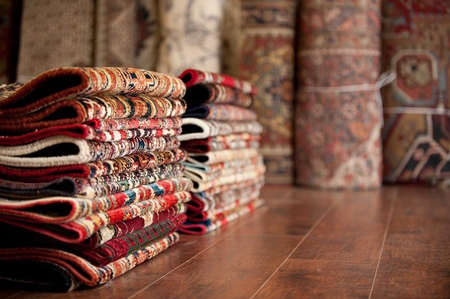
In a dining room a rug should extend at least two feet beyond each of the four sides of the table. This allows you to comfortably move chairs in and out. If you use the leaves of the table then take this into account. For other rooms, the rule is that the furniture should be fully on or fully off the rug. In large rooms you can either use one large rug or a series of smaller ones under seating arrangements. One large rug “pulls the room together” and makes it feel more intimate. Leave at least eight inches space between a rug and a wall. This amount of space doesn’t have to be the same all around. Rug sizes vary, so it’s helpful to know the largest and smallest your rug could be. One way to visualize this is to make outlines with a few pieces of tape.
will sunlight lead to fading of carpet color?
A typical amount of sunlight will not fade quality rugs. The wool in fine rugs is usually dyed with significantly better dye-stuffs than those used in fabric. So, the rugs are much more resistant to fading. If you’re particularly concerned about the amount of sunlight in a room, consider having the windows UV treated and/or making some use of curtains or blinds.
what is the meaning of persian handmade carpet patterns?
Some (but certainly not all) persian rug designs have meaning . For instance, prayer rugs contain a triangular shaped design at one end. This is the end of the rug that is to be laid in the direction of Mecca during prayer. A large, central tree in a rug’s design is often called a “tree of life”. It is considered to represent the immortality of the soul and its connection with the spiritual world above. The rams head design is thought to have originated in prehistoric times and represents the power of the gods. This being said, be a bit skeptical when someone selling rugs waxes eloquent about the meaning of elements in a design. Most weavers aren’t aware of the “meaning” of various motifs. They use them in a rug’s design because they learned them from their mother, not because they’re seeking to convey something.
How do I clean my rug from week to week?
If cared for properly, a fine handmade rug can last for generations. Periodic cleaning will greatly increase the chances of a rug retaining its beauty and value over many years, and a knowledgeable dealer will emphasize this aspect of rug ownership right from the beginning. Regular vacuuming between cleanings will help prolong your rug’s life, but remember – a fine handmade rug is a hand-made work of fabric art, and care must be taken to treat it gently in all phases of cleaning and maintenance. professionals find that the suction wand on vacuum cleaner is especially helpful for lifting pet and human hair from the carpet. When vacuuming, try to avoid going over the fringes. If over time fringes become damaged, do not fret. They can be replaced. Most fringes are made of cotton and are not as durable as the wool knotting. Ironically, worn fringes only add to the value of the carpet. As long as the fringe’s knot is in tact, the rug will remain strong. Never cut a fringe off as this greatly decreases the value of the rug.
How do I give my rug a major cleaning?
Most rugs will not need major cleaning for at least 10-20 years. Do not use harsh chemicals or cleaners on the rugs as the chemicals may react with the dyes. This is especially important for natural dye rugs. Although you can take your rug and have the people there arrange to have it cleaned, a quality handknotted rug can be washed in your driveway with regular soap. Using very little soap (regular clothes detergent, hair shampoo, etc.), scrub down the rug with your fingers or feet and hose it down with water. Rinse very thoroughly as soap that is left in the carpet makes a very stiff pile. Squeegie the pile with your hands or with the side of a dustpan to remove excess water. Before washing, take note of the direction your rug pile is laying. After washing, with your hand brush the pile down in the direction it was lying before it was washed. The rug needs to be dried on a flat surface. Once the rug is dry, with your hands or with a vacuum cleaner, raise the pile by stroking/sweeping in the opposite direction.
What are knots per square inch?
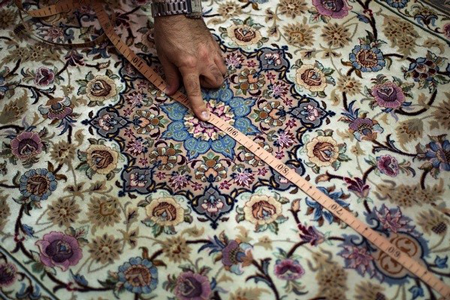
Knots are what are used to hold the pile of the rug to the warps, or fabric base. In a fine rug, the knots are hand-tied, and visible by curling the base and looking between the fibers. Fine silk rugs can have as many as 800 knots per square inch.
What determines the price of a rug?
Rug costs are determined by many different factors including but not limited to age, color, size, design, condition, kpsi (knots per square inch), material (wool, silk, cotton) and rarity. The cost of each rug is also based on labor involved. For example, Persian rugs are quite labor intensive and use more raw materials and therefore usually carry a higher price than some of the tribal rugs.
What is meant by the “dark side” and “light side” of a rug?
All rugs have a light side and a dark side created by the direction of the pile. As a rug is hand-knotted, at the completion of each row, the row is packed down to achieve tight knotting. When the row is packed down it tilts the pile down as well. So, when the rug is completed and lying on the floor, if you are looking into the tilt you see shadow and therefore it appears darker. From the other side, you’re looking across the nap, and therefore it appears lighter. You can usually determine the “dark side” of the rug by standing at the end of the rug and running your hand toward you and the pile will feel smoother. Alternately, the “light side” of a rug will feel rougher when you run your hand on the pile.
Why is my rug a different color in some places?
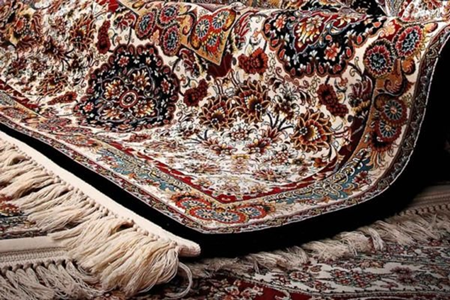
This is a common occurrence in hand made rugs and is referred to as “abrash”. Most often abrash is caused by variation in the dye lots. It is most often encountered when rugs are handwoven in relatively primitive conditions where each dye lot may consist of only 20 or 30 gallons- as opposed to commercially dyed mixed in cities that may consist of 500 or 1000 gallon batches. But there are other causes of abrash as well. There can be large differences in the kind and the natural color of wool used in one rug, and each wool absorbs dye a little differently. Also, when wool is spun by hand, the tension of the spin varies and consequently so does the capacity of the wool to absorb dye.
Why are most rugs made with wool?
Because of their beauty and durability. – and the fact that wool is more resistant to foot traffic than any other fiber. Wool hides dry soil naturally and is not adversely affected by it for quite some time. Wool is a great insulator- in the winter your home will be warmer inside and in the summer it will be cooler. Be aware that there are different qualities of wool and the less expensive wools will stains easily and may not be the first choice where children and pets are present.
If I spill on my rug, what should I do?
Immediate attention should be given to clean spots on carpet . Remove as much of the spot as possible by blotting with a clean rag or paper towel. One cup of cold water mixed with a teaspoon of a mild detergent (Dove or Ivory dishwashing soaps work well), can be used for most spots. White vinegar and water mixed equally can be applied on pet urine spots. This will help neutralize the spot before it sets in. Do not use harsh chemicals or cleaners on the rugs as the chemicals may react with the dyes. This is especially important for natural dye rugs. We cannot be held responsible for rugs cleaned with materials other than gentle soap and water. Avoid using any store purchased carpet-cleaning products. They are generally meant to clean synthetic materials and may have an adverse effect on wool rugs.
What age classification is given to rugs?

- Old = less than 50 years old
- Semi-antique = 50-80 years old
- Antique = Above 80 years old
What determines the length of the pile on my rug?
The higher the knot count, the shorter the pile because the design needs to be brought out. For example, silk rugs with 900-1000 knots per square inch are sheared closely because that allows the design to appear more clearly.
What is the function of the fringes on a rug?
The fringes on a rug are the ends of the warp threads that run vertically from one end of the rug to the other thus forming the structure of the rug. They are knotted as the rug is completed to prevent the warp and weft from unraveling.
